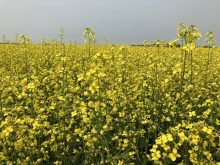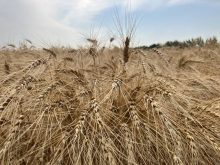Reports that the U.S. spring wheat crop could dip to a five-year low fell short on shock value to Jim Diepolder.
“I thought they might actually be lower,” said the Willow City, North Dakota farmer.
Poor weather, large pockets of scab and a bumper weed crop caused spring wheat yields to dive sharply this year, according to a private survey and backed by recent reports from the United States Department of Agriculture’s agricultural outlook.
The August forecast sets average yield for spring wheat (excluding durum) at 31.3 bushels an acre, up almost a bushel from the July forecast but down nearly four bushels from 1996 and the lowest since 1989. North Dakota’s spring wheat crop estimate is 27 bushels an acre.
Read Also

Supreme Court gives thumbs-up emoji case the thumbs down
Saskatchewan farmer wanted to appeal the court decision that a thumbs-up emoji served as a signature to a grain delivery contract.
Despite a relatively large planted acreage of 19.2 million acres, the USDA expects hard red spring production to decline to 528 million bushels this year.
Dennis Shields, an agricultural economist with the USDA, said the drop in spring wheat yields shouldn’t have much impact on price.
“It would have to be a huge disaster for spring wheat for it (to have an effect) because there’s such a large offsetting increase from the winter crop,” said Shields in an Aug. 25 interview from Washington.
The largest wheat crop in seven years has pushed wheat prices down in the U.S. from $4.35 last year to $3.35 a bushel, he said.
“You still end up with a record U.S. wheat yield and that’s really casting the whole tone through the entire market.”
Diepolder said he’s hoping Canadian wheat producers eyeing the border are paying attention to these latest price estimates.
“It’s piled on the ground from North Dakota to Texas and we certainly don’t need any more from Canada,” he said.
Jim Miller, of the National Association of Wheat Growers, said the low yield forecasts for spring wheat in the U.S. didn’t come as a surprise.
“The acreage was down significantly this year, and then with the combination of dry weather and floods and now scab, I guess it’s not surprising there would be problems.”
There could be an upside for farmers as the market plays out further down the road, he said.
“Winter wheat is not always a good substitute for spring wheat because of the lower protein levels so I would expect that those countries which truly demand high protein spring wheats that there’s going to be a potential premium for the good quality wheat that still will come out of the northern U.S. and Canada.”
Ben Handcock, executive director of the Wheat Quality Council, was part of a group that puts together its own spring wheat yield estimates. Sixty scouts toured more than 500 fields throughout North Dakota, along the Red River Valley in Minnesota and across the northern part of South Dakota during the last week in July.
The tour estimated the 1997 spring wheat crop would average 31.3 bushels an acre.
Scab and weeds were present in most fields, Handcock said.
“It appears the farmer planted when it was dry and he had poor emergence and he just kind of gave up on the crop and all of a sudden it rained,” Handcock said. “He got another crop of wheat come up but also got all these weeds.”
Canada’s milling wheat yield is estimated at 28.5 bushels an acre this year, down six bushels from last year, according to the Canadian Wheat Board.
















